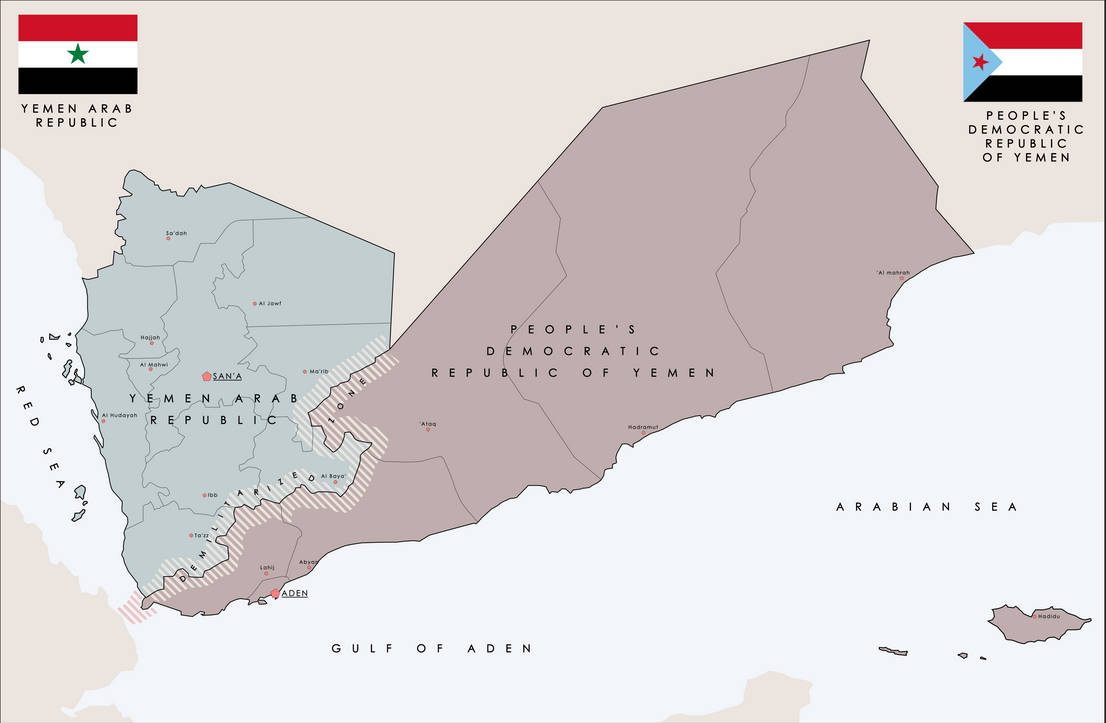
Map showing the borders of two states of South and North Yemen (BrushHikka - deviantart.com)
Last updated on: 08-08-2022 at 9 AM Aden Time

Gregory D. Johnsen (AGSIW)
A western Yemen affairs expert said that “If the United States wants to avoid a disaster scenario in Yemen, it should shift its focus from the failed attempt to resurrect a single Yemeni state to laying the groundwork for a divided Yemen”. He added that “the disaster scenario would fracture Yemen into violent statelets".
According to Gregory Johnsen, former member of the UN Panel of Experts on Yemen, “The Yemeni state, as has been clear for some time, is broken – irreparably and irrevocably broken, like Humpty Dumpty after his great fall”. [1]
In an analysis published by the Arab Gulf States Institute in Washington on Monday, Johnsen added: “Like Humpty Dumpty, Yemen cannot be put back together again, not by the United Nations, the United States, or any of Yemen’s various armed groups”.
Johnsen believes that “Yemen affairs experts and administration officials largely accept this, but U.S. policy does not”.
He believes that “the United States is using its limited diplomatic resources to pursue the unrealistic goal of reuniting the country at the expense of what is actually possible in Yemen” adding that “This is foolish because, as a policy approach, it is guaranteed to fail. And it is dangerous because what is possible now may not be in two or three years”.
The western expert expects three scenarios which will determine the future of Yemen: the dream scenario, the division scenario, and the disaster scenario
The dream scenario
According to Johnsen, “in the dream scenario, the war ends, and Yemen is reconstituted as a single state. The Houthis, who currently hold much of [North Yemen] highlands, are one political actor in the reconstituted state but not the only political actor”.
In light of this scenario, Johnsen quoted the US Special Envoy who said in his Congress speech: “There is an acceptance that the Houthis will have a significant role in a post-conflict government, if they meaningfully participate in a peaceful political process”.
However, this scenario collides with a problem that “the Houthis don’t want to have a significant role, they want to be the post conflict government in [North], if not all of Yemen” according to the analysis.
The division scenario
Johnsen believes that “the current split between Houthi-controlled areas of Yemen and non-Houthi parts of the country is formalized, and Yemen separates into a North and South”.
He added: “Years of de facto control in Sanaa have allowed the Houthis to restructure and reorganize government ministries and agencies in areas under their control. Unwinding these changes will, in many cases, prove impossible, at least in the short term”.
“As distasteful as the division scenario is too many, for those who do not want to see the Houthis rewarded for the group’s aggression, it is the least bad of all the options” Johnson added.
He said: “If the United States waits too long, it won’t even have the option of pursuing partition – instead it will be stuck with the disaster scenario”.
The disaster scenario
The worst case for Yemen, the United States, and the world is the disaster scenario, according to the expert who added: "In this possible future, Yemen fractures into violent statelets that are held by whatever warlord is strongest at any given moment. In such a world, Yemen’s various armed groups are constantly struggling to seize and hold as much territory as possible, which opens up space for AQAP to rebound, sparks massive movements of internally displaced people and refugees, and endangers global shipping lanes through the Red Sea. This is a future to be avoided at all costs”.
Johnsen believes that despite the renewal of the truce which expired on August 2nd, “it is unlikely to blossom into full peace as the Houthis aren’t about to negotiate themselves out of power in Sanaa”.
Furthermore, the former member of the Panel of Experts believes that “Saudi Arabia and its local allies aren’t able to militarily defeat the Houthis, and the United States isn’t going to get involved on the ground to tip the balance. That means the war is likely to drag on, destroying more lives and creating an even worse humanitarian situation”.
At the moment, most of these various anti-Houthi groups are tentatively united as part of the Presidential Council.
But this unity according to Johnson “is unlikely to last indefinitely. The anti-Houthi coalition simply has too many parts – with too much history and too many opposing goals – to maintain a common front”.
Concerns
Therefore, Johnsen believes that the US has to avoid the last scenario and to support "the achievable division scenario, unlike the dream scenario".
He added: “This approach is not without risks as moving toward partition in Yemen may accelerate the collapse of the Presidential Leadership Council. Such a collapse could also provide an opening to the Houthis to fully seize Marib”.
Johnson alleged that Washington’s support of the division scenario “will likely anger large numbers of Yemenis, including those who fear unchecked Houthi rule. However, it is also possible that Houthi governance is stronger now than it would be in any post-war scenario”.
He fears that “at some point in the near future the gap between the reality on the ground and U.S. policy will become so great that the United States will have little choice but to abandon the dream scenario of a reunified Yemen”.
He concluded: “If the United States waits too long, it won’t even have the option of pursuing partition – instead it will be stuck with the disaster scenario”.
South24 Center
Previous article